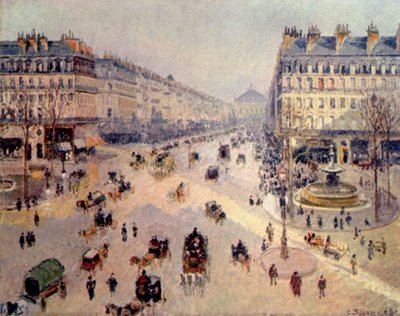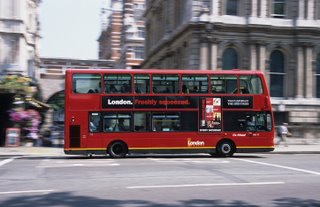Tuesday, March 22, 2011
Tuesday, October 24, 2006
Melting Swiss Glacier in Today's News
The lead photo on the New York Times website was of a Swiss glacier. John Tagliabue's article Frozen In Memories, but Melting Before Their Eyes reminded me of my October 3 post, Glaciers: See Them Before They're Gone. It's an interesting story about how the melting Gletsch glacier is affecting its namesake town.
Posted by
Christopher Gould
at
8:56 AM
0
comments
![]()
Sunday, October 22, 2006
Art Happened Here: Pissarro & the Hôtel du Louvre, Paris
 One of Pissarro's paintings of the Avenue de l'Opera completed in 1898.
One of Pissarro's paintings of the Avenue de l'Opera completed in 1898.Photo Credit: Wikimedia Commons
Camille Pissarro spent the first few months of 1898 at the Hôtel du Louvre in Paris. During that time, he produced a number of canvases sitting at the window of his room. Today, that room is the Pissarro Suite and goes for €1800 a night (a little less than $2300). It has a living area, a bedroom and two bathrooms -- all with large windows that overlook the scene that Pissarro painted. You can even enjoy the view from a deep marble tub.
 The view from the Pissarro Suite at The Hôtel du Louvre.
The view from the Pissarro Suite at The Hôtel du Louvre.Photo Credit: Concorde Hotels
The Hôtel du Louvre has one of the best locations in Paris for seeing all of the big tourist sites as it's sandwiched between the Louvre and the Palais Royale. Views from the upper floors take in virtually every monument in Paris and it is located right next to the Palais Royale - Musée du Louvre Métro Station. It's not the neighborhood for anything quaint or quirky, though. This is Baron Haussmann's Paris of the grands boulevards.
The hotel is a distinguished Second Empire building that's managed by the French Concorde group. The decor is indisputably traditional French, but with a contemporary twist, especially with fabric choices. Check out some of the pictures on their website and see what I mean. I have confidently recommended the Hôtel du Louvre for my clients who want a grand Parisian hotel at a level of luxury (and price) just below the true palace hotels like the Ritz, Meurice and Crillon.
 The facade of The Hôtel du Louvre facing the Place André Malraux.
The facade of The Hôtel du Louvre facing the Place André Malraux.Photo Credit: Concorde Hotels
If you're a art lover, it's hard to put a price on the special experience you can have in a place where an artist found their inspiration -- to see the light change through the day and night -- and have the place all to yourself. It's inspirational to me. I will write more in the coming weeks about more places where art happened.
Tweet
Posted by
Christopher Gould
at
1:47 PM
1 comments
![]()
Labels: destinations, hotels DiggIt! add to Del.icio.us
Friday, October 20, 2006
My Top Ten Free & Cheap Things in London
 A modern double-decker bus cruises up Whitehall.
A modern double-decker bus cruises up Whitehall.Photo Credit: (c) Transport for London 2005
2. See London from the Thames on a hop-on hop-off cruise. Probably the cheapest way to see the river, this cruise stops at a number of convenient places between Westminster and St. Katharine’s Wharf. With the circular ticket priced at £7, you can get off and rejoin any boat later in the day. Crown River Cruises
3. Changing the Guard may be a tourist cliché, but it's truly is worth seeing, especially for the price (free). Get there early to get a good spot by the fence in front of Buckingham Palace. At 11:30AM Monday - Saturday from April until July and every other day except Sunday the rest of the year. May be cancelled due to rain. Buckingham Palace
4. A Church Service or Concert at Westminster Abbey or St. Paul’s Cathedral. Visiting London’s sacred spaces can be a bit expensive for the tourist. Most of them have daily worship which is, of course, free. See Westminster Abbey and St. Paul’s as they were intended – as places of worship. Most churches also offer concerts and recitals as well, the Church of St. Martin in the Fields in Trafalgar Square is a popular one.
 The Lamb & Flag pub.
The Lamb & Flag pub.Photo Credit: Christopher Gould
5. Have a Pint of ale at a traditional pub. There are literally hundreds to choose from. I like ones in very old buildings with taps that require pumping to draw their precious liquid to your glass. One of my favorites is the Lamb & Flag near Covent Garden at 33 Rose Street. It’s one of the oldest in London, at the head of a crooked street.
6. See debate in Parliament. When Parliament is in session foreign visitors may not take the tour, but they can attend a session of either the House of Commons or House of Lords. Get in line at the St. Stephen’s entrance across from the rear of Westminster Abbey on St. Margaret’s Street. On busy days, the wait can be more than an hour. It is possible to arrange a Card of Introduction through the U.S. Embassy in London that will get you preferred entrance to the session, but they are extremely limited. Admission to the House of Lords is usually easier and their chamber is far more splendid than the Commons. If you appreciate history – remember that the Commons met in the chamber of the House of Lords for most of World War II because of bomb damage to their own chamber. UK Parliament
7. Eat Pie and Mash to experience London's traditional working-class food. There are pie shops all over, with some of the best in the East End. My favorite is Manze’s at 87 Tower Bridge Road. It dates from the reign of Victoria and it's not very different from the day it opened by the looks of it. This is as real as it gets -- traditional meat pie with mashed potatoes and parsley liquor. Expect to pay less than £5 for an entire meal. Truly London in a dish. Manze's
8. Go to the (Puppet) Theatre – An incredible jewel-like theater in tony Islington, The Little Angel Theatre, has presented puppets exclusively since 1961. While their normal ticket prices aren’t bad at all, usually about £9 for an adult, they offer a limited number of PWYC (pay what you can) performances where they request a minimum donation of £1 instead of a ticket. Their elaborate productions dazzle young and old alike.
9. Visit an art museum like The National Gallery in Trafalgar Square which houses treasures like Sunflowers by Van Gogh, Samson and Delilah by Peter Paul Rubens and works by Da Vinci, Vermeer and Michelangelo. The Tate Britain at Millbank on the Thames near Vauxhall Bridge showcases works of British artists, including the world’s largest collection of J.M.W. Turner. If your tastes are more contemporary, check out masterpieces by Picasso, Pollack, Monet, Matisse at The Tate Modern located in the former Bankside Power Station on the Thames opposite St. Paul’s. Admission to all three museums is free.
 The big guns outside the Imperial War Museum.
The big guns outside the Imperial War Museum.Photo Credit: Becky Gould
10. Relive the Blitz and D-Day at the Imperial War Museum. Perhaps the greatest military museum in the world has impressive collections focusing on the First and Second World Wars. The Blitz Experience is unique “a carefully researched reconstruction of an air raid shelter and a blitzed street in 1940. Appropriate sights, sounds and smells evoke for visitors a sensation of being caught in the bombing of London during the Second World War.” The Imperial War Museum is located on Lambeth Road in the landmark buildings that housed the Bethlem Royal (Mental) Hospital, better known as Bedlam in the Nineteenth Century.
Tweet
Posted by
Christopher Gould
at
2:30 PM
3
comments
![]()
Labels: consumer tips, destinations DiggIt! add to Del.icio.us
Tuesday, October 17, 2006
Hassle-Free Car Rental Guide Part 2: Europe

Photo Credit: Christopher Gould
This post will expand upon the advice I gave about car rental in the US last month by examining some important issues to consider when renting a car in Europe. It’s much more important to use a travel professional with lots of European experience (like me) when making a car rental in Europe, this advice is just a starting point:
KNOW WHO YOU’RE DEALING WITH – If you reserve a rental car for use in Europe, in many cases the name of the car rental office may differ from the company you thought you were making the rental with. This is especially true in the case of car rental consolidators like Europcar and Kemwel. You need to know what sign to look for.
Many car rental locations in Europe are independent franchisees that may have a relationship with more than one major car rental brand. I recommend using an experienced travel professional to make your car rental arrangements. They should be able to advise you on the business practices of different companies from country to country. It can be quite complicated – in fact, there’s only one company that I recommend in every European country – other companies I might recommend in France but not in Ireland, for example.
GET THE EXACT LOCATION AND HOURS – Locate the rental office on a map in advance of attempting to drive there – get expert advice because house and building number logic may be different from what you’re used to. Be sure to find out the hours of operation for the car rental office you’ll be using. Many on-line reservation websites will let you make a reservation during hours that a location is not open. Be sure.
KNOW WHAT YOUR INSURANCE COVERAGE IS – See my previous post for an overview and be sure to know how your insurance applies in the countries you’re planning to drive in.
KEEP RENTAL AGREEMENT WITH THE CAR – You will need to show the rental agreement if you’re stopped by police and at some border crossings.
DON’T PUT GAS IN A DIESEL CAR – One of the most common mistakes that Americans make with cars in Europe is putting the wrong kind of fuel in the tank. Diesel cars are much more common in Europe and you may get one when you rent. If you put gasoline in a diesel car (or vice versa), you will break down, and it will cost you hundreds of dollars to correct the mistake. Understand that you cannot request one type or another when you make your reservation – you can make a request when you pick up the car if you have a preference – the important thing is to use the right fuel when you fill up.
KNOW THE LOCAL LAWS – Ask your travel professional to help you understand the local laws regarding cars and driving. The laws are not the same and you are responsible for obeying them. Here are some interesting examples: in Ireland you may not drive if you’re older than 75; you may not honk your horn in town in France; in Italy you must wear a reflective vest if you must get out of your car on a highway; in Austria you must display a sticker to show you’ve paid the toll for some roads; some countries require that you carry an International Driving Permit. The list goes on and on – don’t be surprised – find out before you drive.
TAKE YOUR TIME – Remember that you’re on vacation, there’s no need to rush.
Tweet
Posted by
Christopher Gould
at
11:02 AM
0
comments
![]()
Labels: car rental, destinations DiggIt! add to Del.icio.us
Saturday, October 14, 2006
Alert: French Rail Strike Set For Nov. 8
 The TGV Atlantique train speeds through the French countryside.
The TGV Atlantique train speeds through the French countryside.
Photo Credit: SNCF
The five major railway workers' unions in France yesterday agreed to hold a one-day strike on Wednesday, November 8. The unions are dissatisfied with their negotiations with the French national railroad company.
I expect that there will be an almost complete cessations of all rail operations in France on that day -- as has happened during previous work stoppages. Local trains and TGV service will most likely be halted. International service, including the Eurostar and Thalys trains should be greatly reduced, if not completely stopped as well.
It is not clear if the Paris Métro and Paris regional rail (RATP) will strike as well, but I expect disruptions at a minimum. Other cities that have Métro systems: Lyon, Toulouse, Rennes, Marseilles, and Lille; will most likely suffer significant disruption.
If you're scheduled to travel by rail in France on November 8, my advice is to reschedule now. If you're not -- it's an opportunity to see a great French labor movement in action.
I will continue to monitor the situation and post updates as required.
Posted by
Christopher Gould
at
10:40 AM
0
comments
![]()
Labels: destinations, rail travel DiggIt! add to Del.icio.us
Thursday, October 12, 2006
Lonely Phones: Nassau, Bahamas
Photo Credit: Christopher Gould
Posted by
Christopher Gould
at
9:27 AM
0
comments
![]()
Labels: destinations DiggIt! add to Del.icio.us




